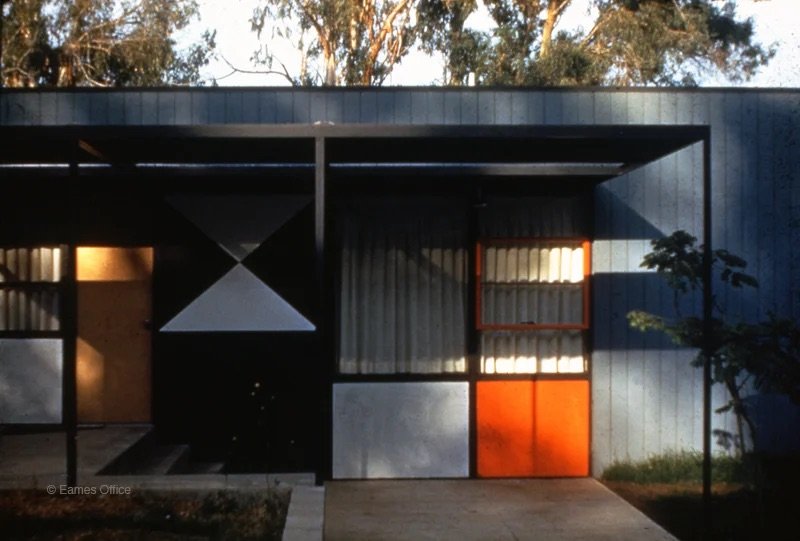About Her: artist, designer, and architect Ray Eames
Image Source: Whipple Russell
Ray Eames was a visionary whose vibrant creativity shaped the modernist movement of the 20th century. Known for her profound understanding of color, composition, and playful innovation, Ray significantly contributed to furniture, textiles, toymaking, interiors, graphic design, and film. Historically overshadowed by her design and business partnership with husband Charles Eames, in addition to contributing to all other areas of the studio’s body of work, Ray was solely responsible for the studio's textile works. In this month’s newsletter, we will have a look into three of our favourites in Ray’s portfolio.
“Somehow I’ve always been interested in structure, whatever form it was—in dance and music, and even my interest in literature had that same base, I think—as structure in architecture.”
- Ray Eames
Born Bernice Alexandra "Ray" Kaiser in Sacramento, California, on December 15, 1912, Ray grew up immersed in artistic and theatrical influences.
Image Source: The New York Times
Her early interests included art and ballet, which led her to New York in 1931 to study under the renowned abstract painter Hans Hofmann. After briefly returning to California to care for her ailing mother, Ray enrolled at the Cranbrook Academy of Art in Michigan, where she met Charles Eames. Married in 1941, Ray and Charles formed one of the most iconic design partnerships of their era, merging their unique talents. To fully dedicate themselves to their work, the Eameses employed domestic help for cooking, housekeeping, and gardening. Although they had no children together, Ray maintained a close relationship with Charles's daughter from a previous marriage.
Image Source: Karakter
This progressive family structure for the time allowed Ray the freedom to focus entirely on her extensive body of work. Their designs have been exhibited internationally for decades at prominent institutions such as MoMA, the Vitra Design Museum, Cooper Hewitt, Triennale di Milano, and the Library of Congress. Ray was also a founding member of the American Abstract Artists (AAA), established in 1936 to promote abstraction at a time when it wasn't widely recognized by major museums and galleries. Ray is now a household name, her work contributing to shaping the homes of families worldwide.
Image Source: Vitra.
Project one: The Entenza House
203 Chautauqua Blvd, Pacific Palisades, Los Angeles (1945-1950)
The Entenza House was among several groundbreaking Case Study Houses designed by the Eames Office for Arts & Architecture magazine editor John Entenza.
Image Source: Eames Office
Completed in 1950, the house is notable for its vibrant exterior panels, reflecting geometric influences reminiscent of Piet Mondrian and echoing Ray’s early mentorship under Hans Hofmann. Inside, expansive floor-to-ceiling windows seamlessly connect the interior spaces to the surrounding landscape.
Image Source: Metalocus
A distinctive fireplace anchors the living area, complemented by integrated storage and shelving—a hallmark of the Eames' approach, merging practicality and beauty by blurring architectural and interior elements. The Entenza house has had several renovations throughout its life, and is now a private residence so is unable to be toured.
Image Source: Eames Office
Project two: The Competition for Printed Fabrics
In 1946, Charles and Ray entered The Competition for Printed Fabrics sponsored by MoMA, receiving an honorable mention for their "Crosspatch" pattern.
Image Source: Eames.com
Exhibited from March to June 1947 in MoMA's "Printed Textiles for the Home," this design was the only print commercially produced at the time, distributed by Schiffer Prints. Ray’s later "Dot Pattern," inspired by the shadow cast by the Eames DCM dining chair, has become one of the Eames House's most iconic designs, significantly influencing future mid-century atomic-inspired aesthetics. Though not produced during their lifetimes, since 1999, Maharam has produced this design, now globally recognized. Ray's "Sea Things" print was similarly adapted by Waverly products in the mid-1960s.
Image Source: Eames Office
Her textiles are available through Maharam Fabrics: (www.maharam.com/maharam/collaborators/eames-charles-and-ray).
Image Source: Eames Office
Project three: The Eames House
203 N. Chautauqua Blvd., Pacific Palisades, California (1949)
Arguably the most celebrated of their architectural works, the Eames House (Case Study House No. 8), completed in 1949, stands as a testament to Ray's significant artistic influence. Built as both their home and office, they used materials from industrial catalogs to form its unique shape. Its distinctive use of color and thoughtful composition reflect Ray’s abstract painterly background. The striking double-height living room, illuminated by expansive windows and softened by warm timber-clad walls, showcases Ray’s signature layering of richly textured fabrics and materials.
Image Source: Whipple Russel
The interiors of their home continue to inspire contemporary design over 70 years later. Fortunately, the house survived the Palisades fires of 2025 and remains open for tours: (eamesfoundation.org/visit/how-to-visit/).
Image Source: Architecture-history
Those who cannot make it to California can tour the house virtually: https://www.youtube.com/watch?v=hv7ipQdUrYk
Image Source: Architecture-history
Ray Eames approached design with a rare blend of precision, playfulness, and vision that still resonates today. We hope you enjoyed getting a glimpse into Ray’s world through this month’s blog.
Text Sources:













